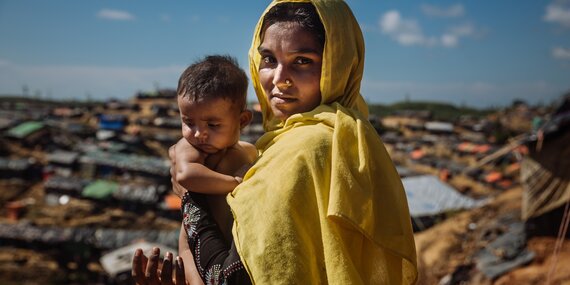Cox's Bazar, Bangladesh
A young Rohingya mother holds her baby. She lives in a shelter in the Kutupalong camp — the world’s biggest refugee settlement. IOM/Muse Mohammed
Under the leadership/co-leadership of humanitarian partners, three other appeals are being developed with the aim to respond to the needs of populations at country and regional levels. UNHCR and IOM will continue co-leading the regional Refugee and Migrant Response Plan (RMRP) for refugees and migrants from Venezuela and the Joint Response Plan (JRP) for the Rohingya humanitarian crisis in Bangladesh. In addition, IOM will continue leading the inter-agency Migrant Response Plan for the Horn of Africa and Yemen (MRP).
Other Appeals
The work of the Regional Inter-Agency Coordination Platform for the Response for refugee and migrants from Venezuela (R4V), now composed of over 190 organizations throughout the subcontinent, will continue to complement host countries’ efforts. The Platform is providing a coherent and consistent response and global visibility to the needs of Venezuelans and their host communities within the region. Reflective of its inter-agency and multisectoral character, the RMRP 2022 is based on joint needs assessments carried out by RMRP partners at national and sub-regional levels on an ongoing basis, and on continuous exchanges with host governments, civil society actors and affected populations. The RMRP 2022 will continue efforts to provide balanced responses focusing on immediate humanitarian and protection assistance, and activities that bridge the humanitarian-development-peace nexus by responding to the longer-term resilience and integration needs of affected populations and host communities.
Bangladesh has generously hosted and provided safety to Rohingya refugees from Myanmar for several decades, particularly in the aftermath of the events of August 2017 in Myanmar. Under the leadership of the Government of Bangladesh, the humanitarian community will continue to strengthen protection and assistance for Rohingya refugees and vulnerable host communities.
Other Regional Appeals
Reflecting on an inter-agency strategy and in support of governments’ efforts in the Horn of Africa and Yemen, the MRP 2022 provides a strategic framework to ensure a whole of society approach to address the needs of vulnerable migrants and host communities in the key countries along the Eastern and Horn of Africa (EHOA) and Yemen route and ensure continuity of services and urgent life-saving humanitarian and protection interventions along the route.
The 2022 RMRP, JRP and MRP will integrate responses to the COVID-19 pandemic across programming with the aim to address health and socioeconomic needs of the populations. Moreover, an age, gender and diversity (AGD) mainstreaming approach is taken by response actors, focusing on persons with disabilities and specific needs. Several cross-cutting priorities are also included in the 2022 Plans: integration of environmental concerns and mitigation strategies; enhancing measures to prevent, mitigate the risks of and respond to sexual exploitation and abuse; and strengthening the empowerment of communities and accountability towards affected populations (AAP).
Horn of Africa and Yemen
Analysis of the context, crisis and needs
The Horn of Africa and Yemen is a region of origin, transit and destination for hundreds of thousands of migrants, the majority of whom travel in an irregular manner. They often rely on smugglers to facilitate movement along the Eastern Route (originating from Ethiopia and Somalia and transiting through Somalia, Djibouti and Yemen) with the intention of crossing the Gulf of Aden towards the Kingdom of Saudi Arabia to seek better livelihood opportunities. Movement restrictions imposed as part of COVID-19 containment measures were eased in 2021, but widespread economic challenges, scarcity of regular migration opportunities, protracted conflict and cyclical natural hazards persisted. They were the main drivers of irregular migration, with 16,080, 60,961 and 23,182 migrants arriving in Yemen, Djibouti and Somalia respectively in 2021. Over 100 deaths and several disappearances were also reported in 2021. Throughout their journey, migrants face extreme weather conditions and harsh terrain, and they are exposed to protection risks and human rights violations, including but not limited to physical assault, xenophobic and discriminatory attacks and attitudes, human trafficking, abduction, forced labour, various forms of exploitation, arbitrary arrest and detention, various forms of gender-based violence (GBV), and the risk of death while crossing the Bab-el-Mandeb strait to the Gulf of Aden. As they pass through Yemen, migrants are also exposed to the effects of the ongoing armed conflict.
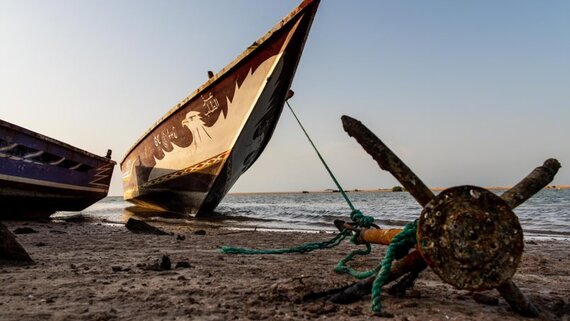
Djibouti
A smuggler’s boat abandoned along the beach in Djibouti. The boat was carrying more than 130 Ethiopian migrants, who were later taken to the IOM Migration Response Centre in Obock.
IOM/Alexander BeeThe deteriorating situation in transit and destination countries has resulted in limited access to life-saving assistance and protection interventions, such as shelter, medical care, water, hygiene and sanitation (WASH), and food and non-food items (NFIs), and limited support from local communities. This leaves migrants with the difficult choice to either continue with their journey or return home, further exacerbating their vulnerability.
The large-scale return of Ethiopian migrants from the Kingdom of Saudi Arabia further exacerbates the situation of migrants who often arrive in a vulnerable state. As of October 2021, 75,300 returnees were registered, including 675 unaccompanied and separated children (UASC). Between August and September, 80 per cent of the returnees were females, many travelling with infants and young children, increasing the need to provide life-saving assistance and specialized protection interventions to returnees. In addition, the situation of returnees to Ethiopia is compounded by the ongoing conflict in some areas of return, particularly in Tigray and parts of Amhara and Afar regions, where 37 per cent of all returnees in 2021 came from. The volatile security situation in these conflict-affected areas has compromised capacities for safe return and augmented humanitarian and protection needs, risks and vulnerabilities in areas where migrants have temporarily found refuge.
Projected situation in 2022 and beyond
With the heightened vulnerability of migrants in transit and destination countries, migrant flows are anticipated to reach pre-COVID-19 levels, with 759,748 people projected to be in dire need of life-saving assistance and protection interventions. This projected figure includes 395,345 migrants and 364,403 host/returnee-community members. The deteriorating economic situation, new and protracted conflicts and cyclical natural hazards will continue to be the main drivers of irregular migration, with a projected figure of 91,436 migrants leaving countries of origin to seek better livelihood opportunities in the Kingdom of Saudi Arabia. Since the number of Ethiopian migrants stranded in transit and destination countries during the pandemic has increased, so will the number of Ethiopians returning from Saudi Arabia, with a projected figure of 7,160 returnees per month.
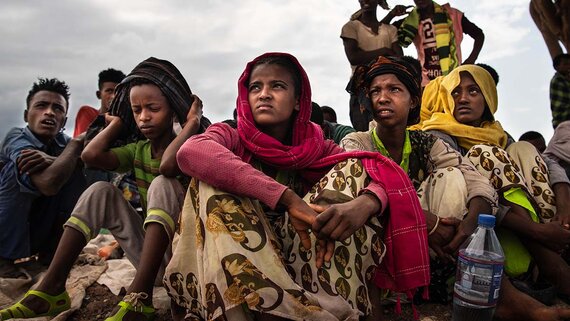
Obock, Djibouti
Transiting migrants sit on a beach in Obock, Djibouti. Throughout their journey, migrants face extreme weather conditions and harsh terrain and are exposed to protection risks and human rights violations, including human trafficking, abduction, various forms of exploitation, arbitrary arrest and detention, as well as gender-based violence.
IOM/Alexander BeeThe ongoing conflict in northern Ethiopia, which is expected to continue into 2022, will result in a deteriorated protection environment for civilians currently in the three states affected by the crisis, and at the same time hinder the sustainable reintegration of returnees, providing an impetus for irregular migration and re-migration. Additionally, access to Djibouti through the Afar Region will be more difficult, with a higher risk of migrants being caught up in active fighting. As such, migrants will have to pay more money to smugglers to use longer routes. Migrants from conflict-affected areas are at high risk of becoming stranded and vulnerable without access to safety networks and basic needs and services. A wide range of assistance and specialized protection interventions, including but not limited to family tracing and reunification (FTR) and mental health and psychosocial support (MHPSS), will become more critical if the conflict continues and migrants’ return home is delayed.
Response priorities in 2022
In 2022, MRP partners will prioritize the provision of life-saving assistance, including food and NFIs, WASH services and specialized protection interventions, such as MHPSS, primary health care, multipurpose cash assistance, FTR for UASC, and legal support for 494,758 migrants and members of the host communities in targeted countries along the migration route. MRP partners will also foster an environment of cooperation and agreements between Governments and among partners, and strengthen Government and non-governmental institutional capacities in reinforcing migrants’ access to protection interventions in line with established standards.
Horn of Africa and Yemen MRP
Furthermore, the response will support the development of policies and laws to improve the protection of migrants’ rights, while strengthening community-based protection structures to support return and long-term reintegration and strengthen referral mechanisms between locations along the route. The assistance will be provided to migrants in vulnerable situations, such as UASC, GBV survivors and victims of trafficking, at response points set/established/rehabilitated along the route and to ensure a continuity of services along the route.
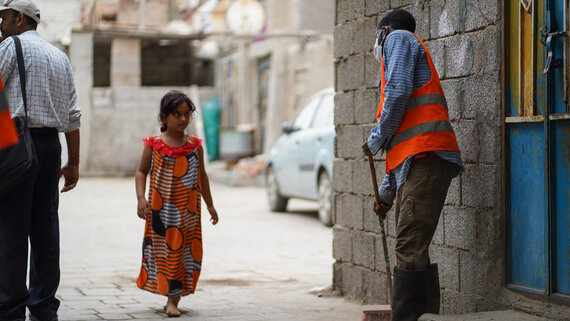
Aden, Yemen
An Ethiopian migrant sweeps the streets in Aden city, in front of a young Yemeni girl. He is enrolled in a cleaning campaign — a project for immigrants in Yemen, supported by IOM in Aden city.
OCHA/Ayman FouadEngaging host communities will be key to the response in 2022. This will be done by implementing community-based reintegration projects, community conversations and support programmes; improving access to livelihood opportunities; establishing hotlines for the national referral mechanisms; and providing alternatives for migration and safety nets. As a result, MRP partners will contribute to addressing the root causes of migration, targeting hotspots of migration and areas of return and helping to build synergies between the humanitarian and development activities. The collection, analysis and sharing of migration data on mobility patterns, root causes, routes, migrant numbers, the protection-related needs, risks and vulnerabilities of migrants as well as partnership-building will continue to be enhanced to ensure informed, coordinated and comprehensive assistance and protection interventions to migrants and host communities along the Eastern Route.
Further reading
Source: IOM
Source: IOM
Source: IOM
Rohingya
Analysis of the context, crisis and needs
Bangladesh has generously provided safety to Rohingya refugees from Myanmar for several decades, most notably in the aftermath of the events of August 2017. Moving into the fifth year of the crisis in the neighbouring country, the Government of Bangladesh and the humanitarian community are providing critical support in an increasingly resource-strained environment. The humanitarian community is committed to supporting Bangladesh in leading the humanitarian response for over 900,000 Rohingya refugees until conditions allow for their return to Myanmar in a safe, voluntary, dignified and sustainable manner.
Rohingya refugees reside in 34 congested camps within Cox’s Bazar District and on the island of Bhasan Char. They are entirely reliant on humanitarian assistance. When the COVID-19 pandemic began, the Government and humanitarian actors scaled up the emergency health response and effectively curtailed its spread in the camps and surrounding areas. Rohingya refugees continue to benefit from the roll-out of the national COVID-19 vaccination campaign. However, in line with strict national COVID-19 measures for significant parts of 2020 and 2021, lockdowns resulted in a drastic reduction of activities in the camps. Similar to other situations globally, this contributed to a deterioration in the protection environment in the camps and heightened the vulnerabilities of women, children, older persons and those with disabilities.
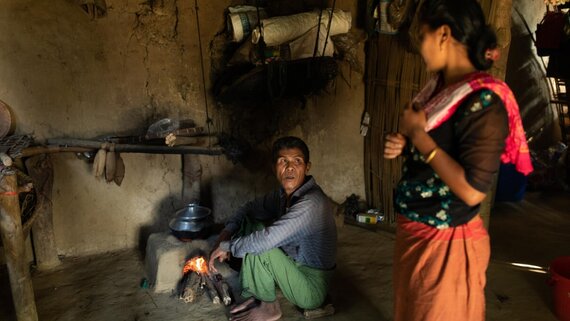
Teknaf, Bangladesh
This Bangladeshi girl stands next to her father. She has been helping him since her mother died in 2017. She struggled to sell her crops and earn a living during last year’s nationwide lockdown. She said: “COVID also affected our production as we couldn’t find labourers to work. We suffered a lot due to the lack of income… sometimes we did not have enough to eat.” The arrival in 2017 of more than 740,000 Rohingya refugees fleeing violence in Myanmar to Cox’s Bazar had a profound impact on local communities. The influx increased pressure on already stretched public services, infrastructure and natural resources.
UNHCR/Kamrul HasanCox’s Bazar District has a Bangladeshi population of 2,650,000, approximately 514,000 of whom reside in Ukhiya and Teknaf Upazilas, where the refugee camps are located. Humanitarian operations have increased local employment and economic opportunities for local populations. However, the growing multifaceted needs of Rohingya refugees and the COVID-19 pandemic have compounded existing socioeconomic challenges, exacerbating pressures on some public services and infrastructure. In particular, multisector needs assessments indicate that host communities members report that some of their most significant needs are access to food, shelter materials and income-generating activities. To prevent potential tensions between communities, it is critical that support continues to be extended to vulnerable Bangladeshi communities.
Projected situation in 2022 and beyond
In 2022, sustained and strengthened assistance will continue to be required in areas including food, nutrition, health, safe water and adequate sanitation, education, shelter and non-food items. The Government and the humanitarian community have effectively managed the COVID-19 response until now, but the trajectory of the virus remains unpredictable. The humanitarian community will continue to be vigilant and maintain its emergency health response capacities.
The overall protection and security environment in the camps has deteriorated over the year, and this is likely to continue without a comprehensive community-led approach. Quality education, including the planned roll-out of the Myanmar Curriculum Pilot, skills development and self-reliance activities will contribute towards mitigating some of these challenges in Bangladesh while also ensuring that the community is better prepared for an eventual and meaningful repatriation and reintegration in Myanmar. Addressing the specific needs of those most vulnerable, including women, girls and boys, as well as persons with disabilities, will remain critically important.
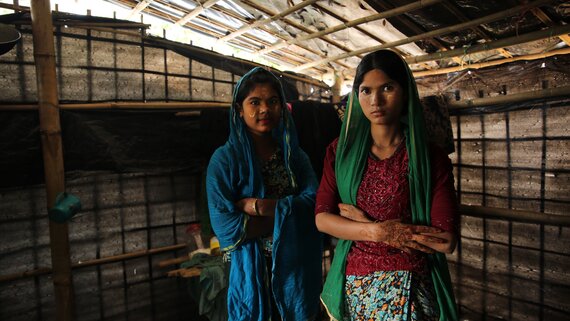
Cox's Bazar, Bangladesh
Two sisters inside the shelter that they share with their family in Cox’s Bazar. When they arrived in the settlement at the height of the monsoon season in 2017, the all-female household had to hire day labourers to build their shelter, which is made of bamboo and thin, ripped polythene sheets. Without any money of their own they relied on private donations from Bangladeshis, who have helped many vulnerable families.
IOM/Olivia HeadonOver the years, Bangladesh has made immense strides to mitigate the loss of life and property due to weather-related hazards, such as cyclones and heavy monsoons that result in landslides, flooding and a spike in communicable diseases. The Rohingya refugee camps and surrounding areas are particularly vulnerable for a variety of reasons, including monsoon floods, fires and climate change more broadly. Building on Bangladesh’s well-established and effective disaster response capacities, efforts to scale up a multi-hazard preparedness and response capacity and to combat the impact of climate change will be essential.
Following the signing of the memorandum of understanding between the Government of Bangladesh and UNHCR (on behalf of the UN) in October 2021, efforts will also need to be stepped up to support refugee communities in Bashan Char. 2022 in particular will require critical investments to set up logistical and other systems on the island.
Response priorities in 2022
Under the leadership of the Government of Bangladesh, the humanitarian community will continue to strengthen protection and assistance for Rohingya refugees and vulnerable host communities. Five strategic objectives will guide the response across all sectors:
- Work towards the sustainable repatriation of Rohingya refugees to Myanmar, focusing on developing refugees’ capacities through the Myanmar curriculum, developing skills that will support their reintegration upon return, and strengthening community-based efforts.
- Strengthen the protection of Rohingya refugee women, men, girls and boys, placing affected communities at the centre of the response.
- Deliver life-saving assistance to populations in need, including maintaining and rationalizing services to ensure equal access to humanitarian assistance.
- Strengthen disaster risk management by improving preparedness for multi-hazard crises and addressing the impacts of climate change within the refugee camps and host communities.
- Foster the well-being of host communities, including through facilitating access to quality services, strengthening public service infrastructure and supporting livelihoods.
Rohingya JRP
A protection framework will guide the response, ensuring a focus on critical protection issues, delivery of targeted protection activities, and promoting community-led, needs-based and participatory approaches to assistance. The humanitarian response will also be underpinned by age, gender and diversity mainstreaming, disability inclusion, a comprehensive approach to protection from sexual exploitation and abuse, and enhancing community engagement and accountability to affected populations.
Climate change and environment
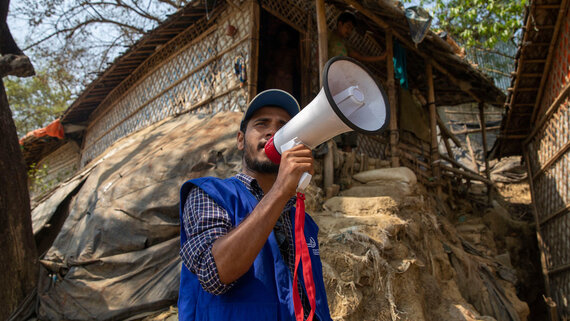
The Rohingya refugee camps and surrounding areas are particularly vulnerable to the effects of climate change and a variety of natural hazards, including cyclones, monsoon floods and fires, requiring a focus on enhancing multi-hazard preparedness and response capacities. In 2022, the Government of Bangladesh and humanitarian partners will step up efforts on disaster risk management, energy and environmental issues in the Rohingya refugee camps and host communities, driven by an additional strategic objective of the Joint Response Plan.
Planning for multi-hazard crises in the Rohingya refugee camps and surrounding host communities will be a key priority across sectors, requiring the development of comprehensive disaster contingency plans that are connected to national and local disaster response systems. Partners plan to bolster camp-level risk management, preparedness and response through training refugee and Bangladeshi first responders, as well as through adequate physical risk mitigation activities, including structural reinforcements, slope protection and adequate drainage systems. Efforts to mitigate the impacts of climate change and support environmental rehabilitation and protection will also be scaled up, requiring the promotion of renewable energy sources, planting and maintaining forestry restoration sites, and seeking appropriate and sustainable solid waste management systems.
In the picture, this Rohingya refugee has been working with IOM to keep his community informed following a fire at Cox's Bazar.
IOM/Mashrif Abdullah AlFurther reading
Source: IOM
Source: UNHCR
Venezuela Regional
Analysis of the context, crisis and needs
Since its creation four years ago, the Regional Inter-Agency Coordination Platform (also known as the Response for Venezuelans, or R4V) and its partners have continuously expanded efforts to respond to the unprecedented outflow of refugees and migrants from the Bolivarian Republic of Venezuela (hereinafter, Venezuela). By the end of 2021, an estimated 6.5 million refugees and migrants from Venezuela will be outside their home country. Seventeen countries of Latin America and the Caribbean covered by the regional Refugee and Migrant Response Plan (RMRP) 2022 are hosting an estimated 84 per cent, or 5.4 million people, of this population.
The large outflows caused by the complex political, human rights and socioeconomic situation inside Venezuela, compounded by the impact of the COVID-19 pandemic over the past 18 months in the entire region, have severely tested the capacities of authorities, host communities and the international aid community to respond to the needs of refugees and migrants.
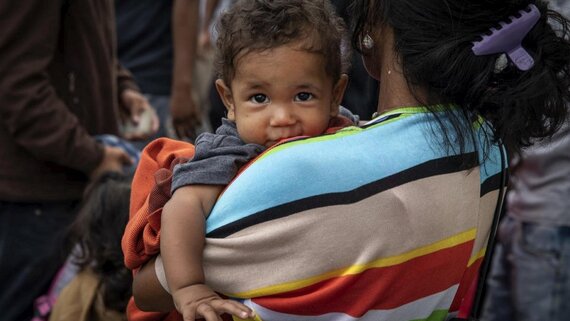
Simón Bolívar International Bridge, Venezuela-Colombia border
A mother crosses the Simon Bolivar Bridge with her child. The ongoing political and socioeconomic developments in Venezuela have led to the flow of millions of Venezuelans into neighbouring countries and beyond. Some Venezuelans have obtained documentation, which allows them to stay legally, but many who left their country have no regular status. This makes them more vulnerable to any form of exploitation, abuse, violence, trafficking and discrimination.
UNHCR/Siegfried ModolaConsidering recent trends in Venezuela, as well as political and socioeconomic developments in several key host countries, the outlook for 2022 remains complex and volatile. Due to pandemic-related border closures and continued travel restrictions, refugees and migrants from Venezuela have adopted riskier coping strategies, including irregular means of travel and border crossings, which expose them to increased protection risks. As a result, a growing number of Venezuelans are in an irregular situation in countries of transit and destination.
In the described context, those refugees and migrants from Venezuela who are considered most vulnerable include survivors of gender-based violence (GBV), victims of human trafficking, persons with disabilities, pregnant and lactating women, young children with nutritional deficiencies, members of traditionally marginalized communities (including the indigenous, elderly and LGBTQI+ communities), as well as those who face a broad range of protection risks and challenges in accessing available services due to their irregular situation.
Projected situation in 2022 and beyond
The 2022 RMRP takes into account national dynamics (including country-specific socioeconomic, political and response capacity-related elements) within an agreed regional planning outlook. Through a participatory survey with R4V partners in all 17 host countries and dialogue with key interlocutors, the following key assumptions were elaborated and guide the RMRP 2022:
- 2022 will be characterized by continued outflows from Venezuela at an overall moderate rate amid a gradual lifting of COVID-19 travel restrictions across the region. This will further aggravate the challenging situation faced by host countries, affected communities, refugees and migrants.
- Challenges related to irregularity will further increase in 2022, including for newly arriving individuals from Venezuela who cannot meet entry requirements, as well as for refugees and migrants already in countries of transit and destination in an irregular situation.
- Secondary and/or onward movements of refugees and migrants from Venezuela, relocating from one host country to another and on new routes, including northwards, will increase.
- New outflows and onward movements will outnumber by far possible return movements to Venezuela.
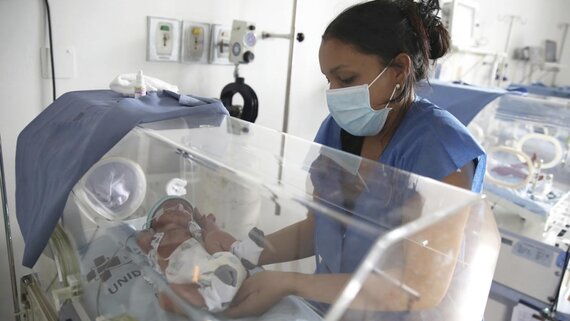
Bogotá, Colombia
A Venezuelan mother from Puerto Cabello cares for her newborn son at Bogotá’s maternity hospital. The Colombian Government enacted a measure that seeks to ensure that children born on Colombian soil to Venezuelan parents are now granted Colombian nationality, which eliminates barriers to accessing education, health care and other essential rights enjoyed by Colombian citizens.
UNHCR/Daniel DreifussGiven this context, the Regional Platform considers that in the countries covered by the RMRP there are some 8.4 million persons in need of assistance. This number includes 4.6 million persons projected as being in-destination, 1.12 million in pendular situations, 645,235 returnees from Venezuela and 2.03 million affected host communities. Of these persons in need, 3.81 million will be targeted to receive sectoral or multisectoral assistance from R4V partners coordinated through the RMRP. This target population comprises 2.55 million in destination, 202,417 in pendular situations and 241,350 returnees. It is also estimated that 824,218 affected host communities will be targeted to receive some form of assistance.
Response priorities in 2022
The RMRP 2022 will bring together an unparalleled number of 192 partners (compared to 159 in 2021) – including 117 NGOs and 23 refugee- and migrant-led diaspora and community-based organizations – to carry out 11,829 proposed activities to benefit 3.81 million refugees, migrants and host communities. The total financial ask of these 192 partners amounts to US$1.79 billion.
The response is organized across nine sectors – Education, Food Security, Health, Humanitarian Transportation, Integration, Nutrition, Protection, Shelter, and Water, Sanitation and Hygiene – and three sub-sectors of the Protection Sector (Gender-Based Violence, Child Protection, and Human Trafficking and Smuggling). The RMRP 2022 also incorporates cross-cutting modalities (such as cash and voucher assistance, or CVA) and cross-cutting themes and priorities, including gender, the environment, communication with communities, centrality of protection, accountability to affected populations and the prevention of sexual exploitation and abuse, to ensure that these considerations are incorporated across all response activities.
Venezuela RMRP
Due to the general health and COVID-19 situation affecting refugees and migrants from Venezuela across the region, addressing primary health care, reproductive health and mental health will be another crucial priority under the RMRP 2022. Direct health interventions, in combination with CVA, will be used to respond to and assist with the costs of treatments, medicines and vaccines. R4V partners across the region will support host authorities in the roll-out of COVID-19 vaccines to all refugees and migrants from Venezuela, irrespective of their situation, including with logistics, equipment (such as refrigeration units) and outreach for immunization campaigns.
Moreover, the RMRP 2022 will prioritize and improve accountability and transparency, including through enhanced mechanisms used to monitor and report on activities implemented and funds received under the response (RMRP Activity Explorer). For the first time, in 2022, the RMRP will also include a results framework linked to the 2030 Sustainable Development Goals to measure the impact and effectiveness of assistance provided by R4V actors. Meanwhile, activities and people reached by R4V partners will continue to be reported monthly through public databases, such as the 5Ws dashboard available on R4V.info, and funds received by R4V partners in support of the RMRP 2022 will be reported using UNOCHA’s Financial Tracking Service.
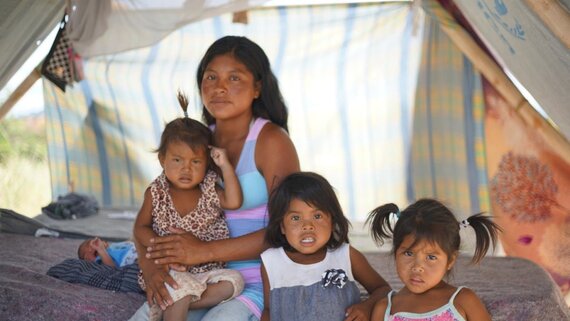
Tarauparu, Brazil
This mother of four found sanctuary in Brazil after abandoning her hometown of Sampay, Venezuela, after armed groups in a nearby city opened fire on protesters, killing and wounding several of her neighbours. Her baby was born just days after she was forced to leave. As of October 2021, a combination of violence, insecurity, and a lack of food, medicine and other services in Venezuela had forced more than 5.9 million people to leave the country, creating one of the world’s largest displacement crises. More than 80 per cent fled to other countries in Latin America and the Caribbean, with Colombia and Peru home to the majority.
UNHCR/Viktor PesentiRegularization and Integration
By 2022, the majority of refugees and migrants from Venezuela will have spent multiple years in their host communities. As a result, their needs go beyond immediate life-saving interventions and include access to regularization and documentation, protection, self-reliance and integration. For this reason, supporting national regularization and documentation initiatives for refugees and migrants from Venezuela in an irregular situation, as part of a process to facilitate successful local integration, is a key priority under the RMRP 2022. R4V partners in countries including Brazil, Colombia, the Dominican Republic, Ecuador, Peru, Mexico, and Trinidad and Tobago, among others, will work collaboratively with host governments to ensure that refugees and migrants from Venezuela have access to regularization and documentation through multiple channels, but including through residence permits (permanent or temporary), humanitarian visas, refugee status determination and asylum procedures, as well as complementary protection statuses.
The environmental footprint of migrations and its humanitarian response
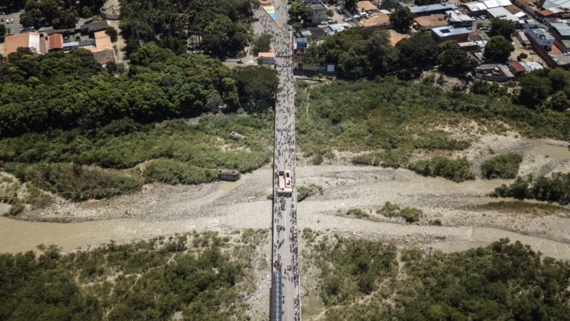
The mixed movements of refugees and migrants from Venezuela and the response offered by humanitarian actors have a significant environmental footprint. R4V partners have taken measures to better take environmental considerations into account. According to the RMRP 2022 self-assessment exercise, more than half of the partners submitting projects have at least partially considered the inclusion of environmental factors into the design of their intervention. An additional quarter intends to carry out environmental assessments before starting implementation. The Shelter, WASH and Food Security Sectors are those with the highest rate of inclusion (over 70 per cent per Sector), reflecting that environmental criteria are already an integrated part of the project planning processes for these sectors. Environmentally-sensitive approaches are rather new for Sectors like Integration and the Multipurpose Cash Working Group, being the ones with the lowest rate (50 per cent in each), but representing an increase of actors planning to include environmentally sensitive approaches in comparison to previous years. In 2022, additional tools and approaches will be developed to support these actors in their environmental response planning and implementation.
Despite the strong interest of R4V actors on environment and climate change matters, gaps and challenges remain. For some partners, especially those who recently joined the RMRP (noting that 90 per cent of the RMRP partners are representing CSOs, including many local and smaller actors), environmental mainstreaming and climate action still represent a new approach, requiring greater guidance. Relatively few of the R4V partners, mostly international organizations, have access to specialized in-house expertise in this field, or can afford external technical expertise to proactively include environmental considerations into their programming. In most cases, partners rely on available general guidance information to mainstream environmental considerations into their activities. Therefore, strategic sectoral approaches at country level, as well as improved access to context-adapted planning tools will be an important way to include environmental mainstreaming and climate action into the RMRP’s planning cycle management.
In the picture, Venezuelans cross the Puente Internacional Simon Bolivar, the busiest border point between Venezuela and Colombia's Norte de Santander Department. Approximately 50,000 Venezuelans cross into Colombia through the three official border crossings in this department daily. While most come to Colombia to work or access services during the day and return at night, between 3,000 and 5,000 who cross the bridge remain in Colombia or continue onward.
IOM/Muse MohammadBased on encouraging developments in a number of countries in 2021, R4V members will advocate for these measures to include as many refugees and migrants from Venezuela as possible. In collaboration with international financial institutions and other development actors, R4V partners will also work towards the socioeconomic integration of refugees and migrants and their inclusion into public policies and services, including COVID-19 recovery and vaccination plans, as well as more long-term social protection systems, such as health, education, housing and other essential services.
Further reading
Source: IOM / UNHCR
Source: IOM / UNHCR
References
- Impact of Covid-10 movement restrictions on migrants along the Eastern corridor
- Response for Venezuelans site
- Inter-Agency Coordination Platform for Refugees and Migrants from Venezuela - Refugee and Migrant Response Plan (RMRP)
- Inter-Agency Coordination Platform for Refugees and Migrants from Venezuela - Key Resources RMRP 2022
- Inter-Agency Coordination Platform for Refugees and Migrants from Venezuela - 2021 RMRP Activity Repository and Explorer
- Inter-Agency Coordination Platform for Refugees and Migrants from Venezuela - Dashboard RMRP 2021
- Inter-Agency Coordination Platform for Refugees and Migrants from Venezuela - Funding RMPR 2021
- See hereto: Environmental Mainstreaming Guidance for RMRP 2020 planning

